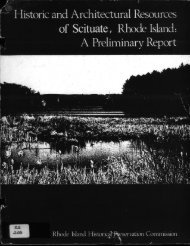1 Dr. Jonathan Prude, Emory University “The Great Transformation ...
1 Dr. Jonathan Prude, Emory University “The Great Transformation ...
1 Dr. Jonathan Prude, Emory University “The Great Transformation ...
You also want an ePaper? Increase the reach of your titles
YUMPU automatically turns print PDFs into web optimized ePapers that Google loves.
3It also allows us to realize industrialization took different forms. It might involve largecentralized manufactories (sometimes called “factories”) or small shops. It might involvecombinations of central workplaces and outworkers toiling in scattered satellite locations,including their homes. It might unfold with or without new technologies, or with technologiesadded only late in the game. It could emerge in urban settings--like New York City which hostedrelatively unmechanized but meticulously sub-divided ready-made clothing businesses. And itcould emerge in the northern countryside, which in these years hummed with the industrialproduction of clocks and palm-leaf hats, shoes and furniture, books and buttons. And also, ofcourse, with the production of textiles. Because if the textile manufactories springing up in theseyears demonstrated their industrial credentials with intricate divisions of labor, they likewiserepresented a form of industrialization that often did depend on machines--and often onmachines driven by the waterpower supplied by streams crisscrossing the northeasterncountryside.Country textile mills were in fact the dominant face of industrialization in southern NewEngland and hence key to the <strong>Great</strong> <strong>Transformation</strong> of this terrain. And they will loom large inmy discussion. But as a further piece of background, we need to appreciate that the mills ofsouthern Massachusetts, Connecticut, and Rhode Island in these years had particular features.They were different, for example, from what surfaced in Philadelphia, where textile productiontook root in mechanized but modest shops linked to urban outworkers. Southern New Englandmills also differed from the famous Waltham-or Lowell-style factories. Inaugurated in 1814 andprominent in northern New England, these mills were typically sizable, heavily capitalized, andincorporated enterprises launched in hinterland communities--but communities which soonurbanized. Committed from the outset to mechanized production of both yarn and cloth,Watham-style mills were further characterized by an initial ambition to recruit workforcescomprised mainly of single young women. By contrast, the textile operations of southern NewEngland--operations that had actually introduced water-powered textile production to America inthe 1790s when Samuel Slater launched his Pawtucket venture, but operations that were then















